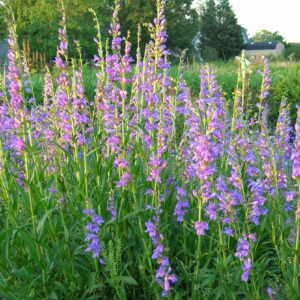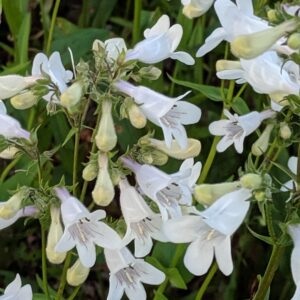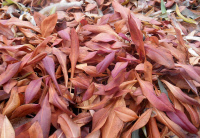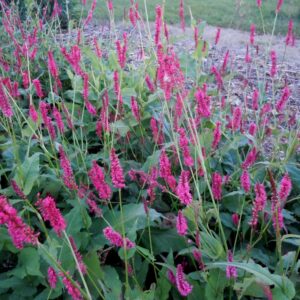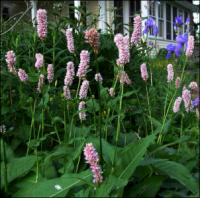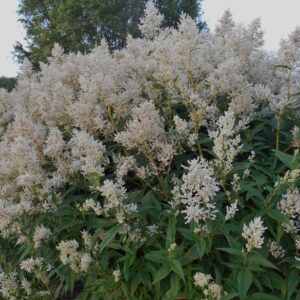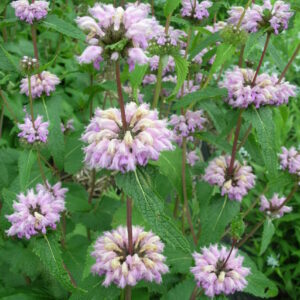Perennials & Biennials
Showing 345–352 of 511 results
-
Penstemon strictus Rocky Mountain penstemon Z 3-8
Spikes of deep purplish-red bells in summer
Spikes of deep purplish-red bells in summer.
Size: 30" x 24"
Care: Full sun in well-drained soil. Drought tolerant
Native: Wyoming to Arizona
Wildlife Value: feeds bees, hummingbirds and butterfliesPenstemon is named for its five stamens, penta meaning five and stemon meaning stamen in Greek. Strictus means “erect.” This species collected by explorer, military officer and politician John C Fremont (1813-1890) and described in 1846.
-
Penstemon tubaeflorus Great Plains Beardtongue 4-8
Spikes of swan white trumpets with flared ends blooms in early summer. One of most reliable, long lived penstemons.
Spikes of swan white trumpets with flared ends blooms in early summer. One of most reliable, long lived penstemons.
Size: 2-3’x 15”
Care: Sun in well-drained to moist well-drained soil
Native: Central Plains N., S. to TX & NE to Maine, Wisconsin native
Wildlife Value: feeds Baltimore butterfly, other butterflies, bees and hummingbirdsPenstemon is named for its five stamens, penta meaning five and stemon meaning stamen in Greek. Collected by English botanist Thomas Nuttall (1786-1859) who searched entire No. American continent – parts of Canada, from New England west to Oregon, parts of the South, Midwest, the Plains, the S.E., California & Hawaii, finding hundreds of new plants.
-
Persicaria affinis syn. Bistorta affinis Dwarf fleeceflower, Himalayan Knotweed Z 4-9
A spreading, mat-forming perennial bearing pink to red flower spikes, blooming late summer and autumn. Foliage turns red in autumn and winter. Good groundcover
A spreading, mat-forming perennial bearing pink to red flower spikes, blooming late summer and autumn. Foliage turns red in autumn and winter. Good groundcover,
Size: 8-12” x 3’ spreading
Care: sun to part shade in moist well-drained soil
Native: high mountains of Nepal in rocky areas and open slopesCollected by plant hunter Nathaniel Wallich (1786-1854) and described by botanist David Don (1799-1841) in Prodromus Florae Nepalensis in 1825.
-
Persicaria amplexicaulis var. speciosum syn. Bistorta amplexicaulis Mountain fleeceflower Z 4-7
queen of flowers with red spikes lasting from June to October
A naming mess. Even experts cannot agree on the name. Flora of China calls this Polygonum amplexicaule var. amplexicaule and lists 7 synonyms. The Missouri Botanic Garden says this is the same as Persicaria amplexicaule ‘Firetail.’ Regardless of the name it’s a queen of flowers with magenta spikes lasting from late June to October. One of internationally known garden designer Piet Oudolf’s “MUST HAVE” plants. Gardens Illustrated 94 (2013)
Size: 3’-4’ x 3’-4’
Care: sun to part shade in moist to moist well-drained soil
Native: Pakistan, Hubei, Sichuan, Xizang, Yunnan in China.
Wildlife Value: deer & rabbit resistant; feeds bees and butterflies
Awards: Silver Banksian Medal from England’s Royal Horticultural Society in 1922. The Royal Horticultural Society also granted an Award of Garden Merit and the Elisabeth Cary Miller Garden named it a Great Plant PickCollected for western gardens by 1825 when described by botanist David Don in Prodromus Florae Nepalensis. Nathaniel Kider exhibited this at the Massachusetts Horticultural Society in 1872.
-
Persicaria bistorta syn. Bistorta officinalis syn. Polygonum bistorta Snakeweed Z 4-8
Erect bubblegum pink bottlebrush spikes stand above ground-covering foliage early to mid-summer.
Erect bubblegum pink bottlebrush spikes stand above ground-covering foliage early to mid-summer.
Size: 12-18" x 2', spreading
Care: part shade in moist to moist well-drained soil
Native: Europe
Wildlife Value: Attracts Bronze copper butterfly other butterflies and beesMany years past in Europe fresh, young shoots used as vegetable and ingredient in spring pudding. Roots used to tan leather, as well as medicinally as remedy for mouth sores and diarrhea. Grown in the Eichstätt Garden, the garden of Johann Konrad von Gemmingen, prince bishop of Eichstätt in Bavaria, c. 1600. Grown in England by Tradescant the Elder, 1634. Grown at America’s 1st botanic garden, Elgin Botanic Garden 1811.
-
Persicaria polymorpha syn.Persicaria alpina, Koenigia alpina Giant fleeceflower Z 4-9
Giant white blizzard of plumes June-September tower atop its 5-6’ stems
Giant white blizzard of plumes June-September tower atop its 5-6’ stems
Size: 5' x 5' (big but not invasive)
Care: sun to part shade in moist to moist well-drained soil
Native: China, Korean peninsula & Himalayas
Wildlife Value: Deer and rabbit resistant
Awards: Great Plant Pick Award from Elisabeth Carey Miller Botanical Garden. Rated “Excellent” by Chicago Botanic GardenOne of the hot “new” plants promoted by landscape designer Wolfgang Oehme. In fact, this plant was collected before 1872 (it flowered in London in 1872, per The Garden) and was described more than 120 years ago by premier Japanese botanist Takenoshin Nakai (1882-1952.) Nakai, professor, author, scholar and appointed official botanist for Korea in 1910 after Japan annexed Korea following the Sino-Japanese and Russo-Japanese wars. There he explored botanically unknown mountains and forests introducing its plants to the world through his international contacts and authoring Flora Koreana. (1909-1910)
-
Petrophytum caespitosum Mat rock Spiraea Z 4-9
Tight cushions bearing white spikes August-September.
OUT OF STOCK
Tight cushions bearing white spikes August-September. Its roots penetrate rock crevices and cracks
Size: 4” x 4-6’
Care: sun to part shade in well-drained soil. Drought tolerant. Do not allow leaf litter to cover it.
Native: Sierras to Rocky MountainsCollected by premier plant hunter Thomas Nuttall 1834-1837 on his exploration across the continent to the Pacific “on high shelving rocks in the Rocky Mountains, towards the sources of the Platte.”
-
Phlomis tuberosa syn. Phlomoides tuberosa Jerusalem sage Z 5-8
Whorls of bubblegum pink, beak-shaped flowers encircle the stem in July.
Whorls of bubblegum pink, beak-shaped flowers encircle the stem in July. One of internationally known garden designer Piet Oudolf’s 100 “MUST HAVE” plants, Gardens Illustrated 94 (2013)
Size: 4' x 12"
Care: Sun well-drained soil
Native: central and S.E. Europe to central Asia.
Wildlife Value: attracts butterflies, deer resistant.
Awards: Chicago Botanic Garden rates this 4-stars for health, robust growth, hardiness and flower production.In garden of English plant enthusiast Peter Collinson, 1736. The name Phlomis is Greek meaning “to burn” “because in old time the peasants used to burn these plants to enlighten their chambers.” Gardeners Dictionary, 1768. This species 1st collected for description and naming in Siberia in 1759.

